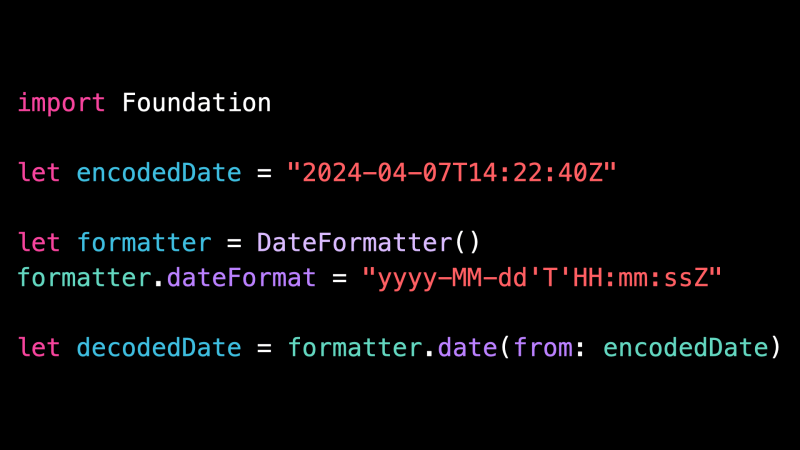Date Format Style Swift – Apple added a much easier way to work with the date, number and other data formats to iOS 15 and Macos 12.
The foundation structure has various formatted for working with dates, numbers, lists, measurements, people’s names and bytes. They all aim to produce a properly shaped rope, located to display the user.
Date Format Style Swift

If you read a lot about using any of these formats, you will find people who warn you to create it. This leads you to storing in cache and re -use in your applications.
Mastering Date Formatting In Swift
In iOS 15 (and Macos 12), Apple wanted to improve this situation. List the WWDC21 session in the Foundation:
This year, we have improved performance and usability in rethinking our API for shaping from the very beginning. In short, our new API -are focused on the format.
Before iOS 15, a typical use of a date formator requires you to create a formator, configure it and use it to make format and located rope a
Starting with iOS 15, you apply formatting directly to this day without the need to create a formator (and cache) of a formator. For example,
Swift Foundation Formatter Improvements
To a date or time if you do not want to appear in the result. There are four date styles:
The output is adjusted by adding a field in style. Exit then contains only the fields you want:
The order you add fields doesn’t matter. Formator gives an order based on a field that includes:

Format field, you get a formated sequence of attributes. This is useful when you want to format output components:
Working With Dates
Create an attribute tank for the date of the date you want to format the other for the attribute you want to apply. For example, to change the Swiftt Forty Time Zone Plan:
To see the values allowed for the foundation, Swiftui, Uikit and Appkit. Make sure to be imported heading so that Xcode automatically completed works. In this guide I will take you in 10 steps to overcome the rapid handling dates. We will deal with everything, from generating an instance of date to work with time zones, dealing with certain formats of the date, analyzing the date sequences, storing the date in the database and calculating the date and time.
Keve component is Swift DatefFatter, which helps turn the date into a string. Allows you to define a specific format style. Also, if you use Swiftui, the text display makes it easier to display the date on your applications.
At the end of this textbook, you will have a firm understanding of quick handling data and you can confidently turn the dates into wires and format them according to your application requirements. Let’s dive!
Swift Hq On X: “‼️| The Release Dates For Red (taylor’s Version), Speak Now (taylor’s Version) And 1989 (taylor’s Version) Have Been Changed To The Release Dates Of Their Respective Original Albums
The type of fast date represents one point in time, to the share of the second. It is a key species used to deal with and manipulate dates and times. Consider this as a record of a date and time that exclusively identifies one moment.
But there is something interesting here: the type of fast date does not have the concept of time zones, calendars or places. It’s just a particular point, and all of these other details are treated separately. Because of this, you usually need to use other species, such as Dateformterter, when working with dates.
Creating a fast date current can be done in many ways. The most common methods are the use of date () and date.

When you need to create a date with specific components or a time interval, Swift provides appropriate methods and beginners to do so.
How To Insert Current Date And Time In Microsoft Excel
To create a date that determines your individual components, you can use the calendar classes and datacomponents. Here’s an example of how to create an object of a date represented on February 14, 2023 at 10:30:
In this example, we first created an instance of calendar.Current, which represents the current calendar that uses the system. We then initialize the facility with Datacomponents and set the desired values of the year, the month, day, time and minute. Finally, we use the date (the methods of calendar to create an object date. If the components are valid and represent a valid date, the date of the date will maintain the results of the result.
If you have a time interval that represents seconds from Epoch Unix (January 1, 1970), you can use TimefrailSent1970 🙂 Ininizator to create a date facility. Here’s an example:
In this example, we have created a variable of a time interval that represents a certain time interval from the time of Unix. We then use the time -fo -foam1970 initialization date: to create an appropriate date of date.
Rest Api Calls In Swift: Ios Networking Architecture [in Swiftui]
These methods allow you to create an object of date with certain components or on the basis of time intervals, offering flexibility of operation with dates in a precise and adaptable manner.
The SWIFTUI DATE selector allows users to visually select the date (and if desired, time), through a shift wheel, a calendar -style screen, or even a combination of these intake methods. This is an essential element for any application that needs to collect information related to the date of users, such as the date of birth, the date of commitment or deadlines.
$ Selecteddate connects the selection of the date with the selected state property. This means that whenever the user selects the date with the selection of the date, the selected property is updated.

Datepicker allows you to adjust. You can limit the date range the user can choose using IN: and you can even change the components that the user can choose (as they display only the date rather than the time) using the dysplaedcomponents parameter.
Format The “expiration Date” Fields Exactly The Same As The Physical Credit Card (72% Don’t)
In this case, the Datepicker will allow you to select a date from the current date (date () of the interruption operator) in the future and display only part of the selection date.
If you want to know more about Swiftui Picker, see this postwiftlu Picker Easy: Tutorial with an example.
When working with Swift dates, it is crucial to understand the standard format of dates and time. Swift follows the Technical Standard of Unicode #35 (UTS #35) to display date and time. The standard format is based on ISO 8601 standard, which provides a clear and unambiguous way to present date and schedule.
Represents May 19, 2023 at 10:30 UTC. In this form you can see exactly in examples of the code above, where I used printed instructions.
New Approach To Date Formatting In Swift
It is important to recognize this standard format because it can be useful when working with date conversions, analysis or displaying date in a given view.
In the next few steps, we will explore how to work with Datefttter to format the dates on different requirements and adjusted the date that represents the specific design needs. Let’s move on to Step 2 and deepen the use of DateFfatter to form a date on the Swift.
Dateformterter is a super useful Swift tool that allows you to form a date just as you want. For starters, you need to create an instance of ‘Datefortfatter’. Here’s an example of how I do:

Once you have prepared your date form, you can adjust the design options to match the desired date format. Here are some usual format options that you can adjust:
How To Display Date And Time In Swiftui
In this example, I defined Datestle as .medium and Timesle for .Short. Then I use a series of (method 🙂 to design the current date and time according to the styles of date.
But wait, there are more! You can be creative as you want with a dateformat and create your own custom dates formats. It allows you to use symbols for shaping like “AAA” for the year “mm” for the month “DD” for the day and more.
Therefore, if you want to display dates in a particular style or create your own unique format, Datefratter has put on your back.
By using the DateFratter in the Swiftui application, you can use it to format and display the date within your views. Here’s an example of how you can install a DatefFatter in the Swiftui application:
Formatted. New Way Of Formatting In Swift
In this example, we define the property of the datefatfatterter within the structure of contentview. Dateformformorter is created as a closure to ensure that it is initialized only once. We define the desired date of the date and the time style for .medium and .hort, respectively.
Inside the body of the vision, we use the Dateforter.string method (up to: date () to form the current date and time.
The younger and lightest way to convert the date of date is available for Macos 12.0, iOS 15.0, yours 15.0, Watchos 8.0. The date has a new formatted function that returns a formatted string. The following code illustrates a simple example:

The formatted function has 2 optional parameters that you can use to adjust the returned sequence format. Here’s a simple example:
Julian Loves Diamonds Necklace 16″ … Curated On Ltk
When working with dates, it is crucial to consider the time zones to accurately represent dates in different regions. Swift provides strong support for resolving time zones. Let’s research how time zones are used in the Swiftui app with the example of the code.
To demonstrate the weather zones, we show two information. The first text screen shows a shaped date and time using the Datefratfatter.string method (to: Date ()). This view is shaped according to the time zone of the device. Swiftui gets the current value and transmits its value in the environment:
The second text screen shows the current date description using a date (). Property description. This description follows UTC (universal coordinated time) standard, which is global time.
Including the second text sight, we













